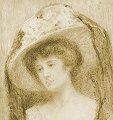|
In the
collection of Wolverhampton Art Gallery there are three
rather interesting artworks by a practically forgotten
locally-born artist – Sara Wells Page. In 1926, she
herself presented her large-scale oil painting ‘Andromeda’
to the Gallery. In 1943, her sister Miss
Elizabeth Page of Parkstone, Dorset donated a small
portrait ‘The Princess’, marking Sara’s death.
Finally, a painting ‘Whisper of Spring’ was
donated by members of the Page family in 1977.
Sara’s
life and artistic career have not been researched. The
period of her artistic activity is usually dated
'fl.1892-1899', and the dates of her life were not
established so far.[1]
A comparison of the data provided by the censuses of
1861-1901 allows us to recognise her as the fourth of
the nine children of Samuel Page and Sara, neé Wells,
born in 1855 at Moxley, Staffordshire.
The Page
family was well-known in Wolverhampton. Sara’s father
was a successful timber merchant. Her elder brother
Samuel Wells Page (1849-1933), was also well respected
in Wolverhampton as a solicitor and the official
receiver for Wolverhampton and Walsall. He was a member
of the executive council and a guarantor of the
Wolverhampton Art and Industrial Exhibition of 1902.
Later he became a manager of the Royal Wolverhampton
School, and was the chair of its governors from 1910 to
his death in 1933.[2]
In memory of him, his children presented a small
sculpture of Venus after Canova to the Gallery. His
Wolverhampton home was Penn House on the Penn Road,
demolished soon after the First World War. Samuel Wells
Page has been commemorated on a brass memorial in the
north aisle of St Bartholomew’s church.[3]
|
|
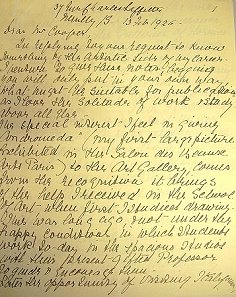
Illustration 1.
Sara Page’s autograph, 1926. ©Wolverhampton
Art Gallery. |
The 1881 census shows Sara as head of the household
at the Redcliffe, Upper Penn, Wolverhampton, where she
lives with her sister Fanny and brother Alfred, a bank
clerk. Both Sara and Fanny are named as annuitants. At
that time, she was studying at Wolverhampton School of
Practical Art, and she was still in Wolverhampton in
1883, when in the Fifteenth Annual Report of the School
of Practical Art her name appears among these of donors
to the Prize Fund: ‘Miss Sara Page £1.1.’[4]
A short correspondence from 1926 which accompanied
the donation of the ‘Andromeda’ and has been preserved
at Wolverhampton Art Gallery, reveals her warm feelings
towards the school and long-lasting grateful memory of
it: ‘The special interest I feel in giving
‘Andromeda’ /…/ to the Art Gallery, comes from the
recognition it brings of the help I received in the
School of Art, when first I studied drawing. This was
long ago and not under the happy circumstances in which
students work today in the spacious studios with their
present gifted professor to guide and encourage them.’[5] |
| The same correspondence provides other glimpses into
events of her life, although, unfortunately, she never
mentioned any exact date for them. She left
Wolverhampton when ‘later the opportunity of visiting
Italy came, and there I learnt to admire the works of
the great masters of Renaissance, almost living in the
galleries of Florence and Rome, sometimes trying to
penetrate their thoughts by copying.’[6]
This period of her life can be dated between
1884-1891, as in 1892 she was back in Wolverhampton. At
that time she was associated with the Royal Birmingham
Society of Artists, exhibiting there a painting ‘A
Golden Venetian’ obviously influenced by her Italian
impressions. It was probably at RBSA that she was
encouraged by Sir Frederick Leighton to continue
studying art. ‘One day, Sir Frederick Leighton
passing by, asked if I really desired to attain and when
I said yes he advised me to go to school. This I
followed, coming to Paris.’[7] |
She came to Paris, it seems, in the same year, 1892,
and entered the famous Académie Julian which already had
an international reputation as an outstanding and highly
successful art school. It offered to both male and
female students the same training, including drawing
from live models, and famous artists were invited to
advise students. By the 1880s it counted over 600
students, among whom were many women for whom the school
opened a way to the world of professional art.
Almost every country of Europe, Asia and America can
present an impressive list of renowned national artists
trained at some point of their career at the Julian: the
Russians Maria Bashkirtseva, Anna Golubkina, and Eugene
Lancerey; the Finnish Pekka Halonen, the Czech Alphons
Mucha, the German Max Slevogt, the Mexican Diego Rivera,
and many, many others.[8]
|
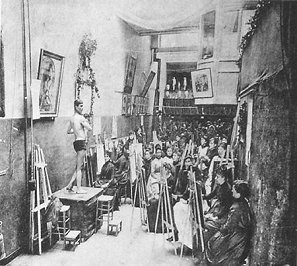
Illustration 2. Academie Julian
rue de Berri. |
|
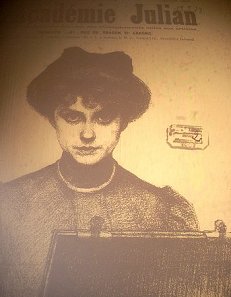
Illustration 3.
Academie Julian
Journal. 1907. ©Biblioteque Nationale de France. |
Male and
female students were trained separately. Five ateliers
were established for men, and four for women. An
American guide book especially addressed to young women
and published in USA in 1907, listed them as
‘Julien's Ateliers, for women: 27, Galerie Montmartre,
Passage des Panoramas; 5, rue de Berri, Champs-Elysees;
28, rue de la Fontaine, en haut de la rue Notre Dame de
Lorette; 55, rue du Cherche Midi, pres du Bon Marche.
Prices: 50 francs a month for those working half a day;
100 francs a month for those working morning and
afternoon.’[9]
Unfortunately, among surviving papers of the archives of
the Académie Julian there are no lists of female
students[10].
A monthly journal of the Académie which has been kept at
the National Library of France provides a rich and
interesting background. However, it does not cover the
1890s, when Sara studied at the Julian, but the later
period of 1901-1914. |
| The extensive list of students compiled from various
sources by Catherine Fehrer ‘does
not include all who were ever enrolled there. It is an
attempt to list those students who later had careers and
some recognition in the art world.’[11]
Sara Page has been omitted from the list. |
| The catalogue of the 1893 exhibition of the Société
des Artistes Français, names Sara as a pupil of ‘MM
Bouguereau, T Robert-Fleury et G Ferrier’.[12]
Adolphe-William Bouguereau (1825-1905), Robert-Fleury
(1837-1912) and Gabriel Ferrier (1847 -1914) were at
that time leading tutors at the Académie, and both
Bouguereau and Robert-Fleury taught at the atelier in 5,
rue de Berri.
Sara Page’s first known Parisian addresses -
16, Avenue Niel and 6, rue de
Belloy - were very near to it, and so she probably
attended this particular workshop.
It was noticed that Bouguereau ‘was
especially sought after by young women who valued his
teaching experience and his ability to work with them in
establishing professional artistic careers.’[13]
‘In the rue de Berri workshop he was given a
godlike status and was the object of veritable cult… The
ladies fought over the cigarette that he had politely
discarded, before entering into their midst, while
handling his hat and his jacket to Leontine, the maid.’[14] |
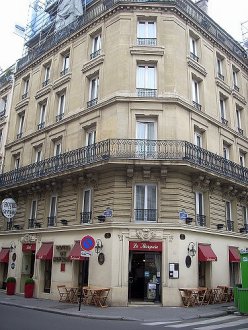
Illustration 4.
Academie Julian. 5,
rue Berri, Paris. |
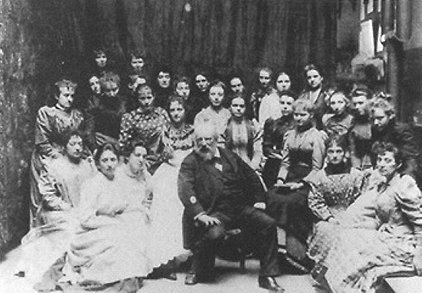
Illustration 5. Adolphe-William
Bouguereau with his students. 5, rue de Berri. 1896.
| Sara Page wrote that she ‘worked under the best
French artists at the Académie Julian and found there
both guidance and much interest in the companionship of
many different nations, and as all the students (about
500) competed in efforts for the medal in painting and
sculpture, life was animated.’[15]
Among Sara Page’s fellow students
and acquaintances might have been the Polish Anna
Bilinska-Bogdanowicz (1857-1893), the Canadian Sophie
Pemberton (1869-1959), the British Henrietta Rae
(1859-1928), the Americans Lilla Cabot-Perry
(1848-1933), Anna Klumpke (1856-1942) and Elizabeth
Gardner (1837-1922) who in 1896 became the second wife
of Bouguereau, and other international female artists
many of whom would make significant contributions to the
artistic life of their native countries.
Women artists were most likely to
earn their living as portraitists, thus much attention
was given to drawing models and each other. Sara Page
received a medal for portrait painting.[16]
Her artworks were exhibited from 1892, and her first
portraits depicted members of her extended family who
probably visited her in Paris: ‘Elsie’ which was
exhibited in 1892 at the Royal Academy can be identified
as ‘Elsie Page’ shown there again in 1894. The ‘Portrait
of Mlle E.P.’ exhibited in 1893 and 1895 at the
Société des Artistes Français, might also be the same
portrait. ‘Portrait of Miss Ellen Wells’
exhibited at the Royal Academy in 1893 also relates to a
family member (possibly an aunt on the maternal side).
In the following years she continued to paint female
portraits – ‘Beatrice’ (1899), ‘Theodora’
(1903), ‘Blondina’ (1914), ‘Isobel’ (1915,
1916), ‘Henriette’ (1935). The Wolverhampton
small painting on ivory ‘The Princess’
corresponds with the drawing ‘La Bella’ exhibited
at both the Royal Academy and Walker Art Gallery in
Liverpool in 1902. |
|

Illustration 6.
Sara Page. The Princess.1901. ©Wolverhampton
Art Gallery. |
|
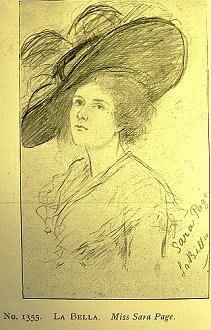
Illustration 7.
Sara Page. La Bella.1902.
Present location unknown. |
|
‘A
Capri Maiden’ exhibited in Birmingham in 1894,
possibly relates to her earlier Italian travels, or it
might reflect another journey to Italy. ‘The Breton
Peasant’ shown in 1893-1894 corresponds with the
great interest in Brittany, its nature, landscape, folk
costumes and traditional ways, which was expressed at
that time in works by many international and French
artists, including Bouguereau. In 1897, Sara still was named a pupil of Bouguereau,
Robert-Fleury and Ferrier, but at that time she was
finishing her study at the Académie Julian, as in the
same year she settled down at Neuilly-sur-Seine, a
wealthy residential suburb of Paris. It was quickly
developing at that time, and it had a strong artistic
atmosphere.
The well-established artists Pascal-Adolphe-Jean
Dagnan-Bouveret (1852 – 1929) and Gustave-Claude-Etienne
Courtois (1853-1923) lived in Neuilly-sur-Seine and
maintained their studio at 73, Boulevard Bineau[17].
|
| Along with Bouguereau, both artists were leading
exponents of the academic style with its meticulousness
of execution and finishing, and continuous interest in
spiritual subjects. As well as the Académie Julian, the
Courtois' studio
also was highly recommended for female students: ‘Monsieur
Gustave Courtois, Chevalier de la Legion d'Honneur,
Delegue de la Société Nationale des Beaux Arts, has a
studio in a villa at Neuilly-sur-Seine. Price for
lessons: 100 francs a month for working all day. There
is a living model from 8 am till noon. In the afternoon
the work is still life, sketches, portraits, etc.
The garden connected with the studio is a
delightful place for winter work as well as summer.
There are not too many students, and those who go there
are well advanced. Monsieur Courtois visits the studio
every day, and criticises. Of course, this is more
expensive than to have his criticism twice a week at a
large studio in Paris, but it really pays in the end.
This studio is eminently proper in its atmosphere, and a
safe place for any girl.’[18]
Unfortunately, the building itself has been completely
rebuilt, but the spacious old garden still exists today. |

Illustration 8. 73, Boulevard Bineau.
Modern view. |
| An old hand-written label attached to the reverse of
the painting ‘Whisper of Spring’ given to
Wolverhampton Art Gallery in 1977 states that Sara Page
indeed was a student of
Courtois and Dagnan-Bouveret, and she herself
wrote: ‘I … found a studio for working alone,
the generous masters continuing to allow me visit
theirs, and follow their pictures through their
different stages. I learnt in this way the importance of
putting character, masses and values before what so
frequently tempts the inexperienced, to try and make a
picture attractive at the expense of the greater side of
Art.’[19]
Between 1897 and 1912 Sara lived literally
two streets away from Courtois’ studio, in the rue
Perronet. She changed her address twice, but still
remained in the same street. Her studio was probably at
50, rue Perronet, as this house has an extention – a
little building with a roof-light. |
|
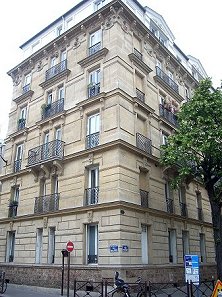
Illustration 9.
45, rue de Marche
(today rue Madeleine Michelis). Modern view. |
|
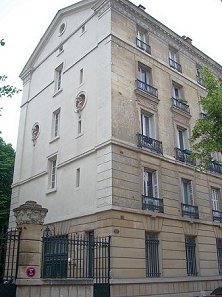
Illustration 10.
83, rue Perronet.
Modern view. |
|
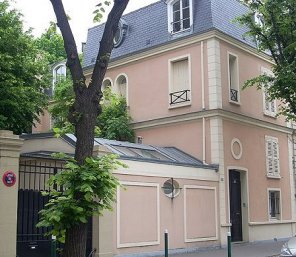
Illustration 11. 50, rue Perronet. Modern view. |
The large-scale ‘Andromeda’ was exhibited at
the Société Nationale des Beaux-Arts (SNBA) in 1902.
It clearly demonstrates a familiarity with drawing
from a live model and attempts to reach technical
perfection.
Both ‘Le rocher qui pleure’(The Weeping Rock)
exhibited in 1910, and ‘Le Baigneuse’ (The
Bather) exhibited in 1911 and 1935 are very similar to ‘Andromeda’
in style, composition, and technique.
As such, they can be seen as very good examples of
the French academic style of Bouguereau, Dagnan-Bouveret,
and Courtois. |
|
In 1913 she moved to 37,
rue Charles Laffitte – slightly further away, but still
in the same area –and lived there for the next thirteen
years.
At that time she seems
started to become interested in miniature portraiture.
As late as 1925, she was named as a pupil of the
miniature painter Gabrielle Debillemont-Chardon
(1860-1957).
The daughter of the
composer J-J Debillemont, Gabrielle successfully
exhibited her artwork from the age of 16, and later
became the President of the Société des Femmes Peintres
et Sculpteurs and of the Société des Miniaturistes et
des Arts Precieux. For years, she taught at many
Parisian art schools for women.
Living permanently in
France, Sara however, kept up relations with her native
country and its artistic circles, exhibiting her works
at British galleries.
From 1896, her London
agent was Percy Young, a publisher, and importer and
manufacturer of artists' materials, based at 131 and
137, Gower Street and was well known to such artists as
Gwen John, Gwen Raverat and Dora Carrington.[20]
In 1906, she showed at the
Society of Women Artists, London the painting
‘Spring’ - for the price of £30.[21] Around the beginning of the First World War, in
1913-1915, she exhibited at the Royal Academy, London ‘The
Rose Scarf’ (1913), ‘Blondina’ (1914), and
‘Isobel’ (1915-1916).[22] |
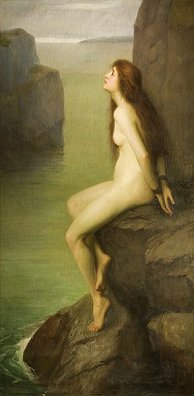
Illustration 12.
Sara Page. Andromeda.
Oil on
canvas, 1926. ©Wolverhampton Art Gallery. |
|

Illustration 13.
Sara Page. Le Rocher qui pleure
(‘Weeping Rock’).
Oil on canvas. 1910.
Location unknown. |
|

Illustration 14.
Sara Page. La Baigneuse’ (‘The
Bather’).
Oil on canvas. 1911. Location unknown. |
Her relations with her extensive family also can be
traced: The Christmas of 1925 she spent with her brother
Sam Wells, at Penn House, Wolverhampton, where the
household had much changed during the First World War.
Two of his sons, Sara’s nephews, died: Captain John
Kenneth Samuel Page died of wounds after the battle of
Somme, in August 1916, at the age of 22, and was buried
in the Sucrerie Military Cemetery, Colin Camps, Somme.[23] |
|
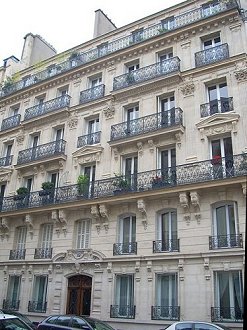
Illustration 15. 37, rue Charles Laffitte. Modern
view. |
Lieutenant Raymond Charles Page died of wounds in
September 1918, aged 41, and was buried at the
Tettenhall Regis (St. Michael) Churchyard,
Wolverhampton.[24]
Both are commemorated at St. Bartholomew's Church.[25]
It was then
and there that Sara decided to give to Wolverhampton Art
Gallery her 1902 painting ‘Andromeda’.
Thanking the
Committee of Art Gallery for accepting it, she wrote: ‘Mr
Cooper gave me the kind message of the Committee
accepting for the Gallery my picture ‘Andromeda’ which I
have great pleasure in presenting and shall feel
honoured for it will find a home on the walls where I
have so often admired many works of art. The subject has
always appealed to me, symbolical as it is, of those
days of chivalry when strong men protected the weak, and
when many episodes of the Great War made them proudly
[give?] lives on ever the same…’[26]
|
| Sara Page returned to England towards the end of her
life. From 1934, all her known addresses are in England.
A painting shown at the Royal Birmingham Society of
Artists in 1934 was exhibited from 122, Argyll Avenue,
Luton, which was then her brother Charles' address.
She possibly supervised and encouraged the art
training of his son, as in 1935-1938, Charles W[ells]
T[homas] Page exhibited several landscapes at the Royal
Birmingham Society of artists: in 1935 - also from 122,
Argyll Avenue, Luton, and then from Bewdley, Carisbrook
Road, Harpenden. [27] |

Illustration 16. 37, rue Charles Laffitte.
Detail. |
|
In 1935, she moved in with her sister Elizabeth Page, to
Parkstone (Poole), Dorset. From there, she exhibited the
miniature 'A Russian Princess' at the Walker Art
Gallery. This was possibly the same miniature which had
been exhibited in Paris in 1901, and which was given to
Wolverhampton Art Gallery in May 1943 by Miss Elizabeth
Page. The adjective 'Russian' appears only in the
Catalogue of the 61st Autumn Exhibition of Walker Art
Gallery, and the sitter has not been identified. Sara
died in 1943 at Parkstone. Her death was registered in
January-March 1943 in Bournemouth district. While
donating ‘The
[Russian?] Princess’ to the Gallery in May 1943, Miss Elizabeth
Page wrote to the curator of the Art Gallery: ‘Will
you convey to your Committee my warm thanks and
appreciation of the honour they have paid me by their
gracious act of accepting the miniature painted by my
dear sister. Could she have known, nothing would have
given her greater happiness, for she always remembered
with gratitude the valuable instruction she received at
the Wolverhampton School of Art where she made her first
art studies.’[28]
Two accomplished pastels by Sara depicting a
strikingly elegant young woman have been preserved at
Poole Museum. Considering the location of the artworks
and dress-style of the sitter which can be dated late
19th century, they may be portraits of her sister Elsie
(Elizabeth) Page which were exhibited from 1892-1896.
Moreover, the second portrait bears a printed label on
the backboard, 'Papeterie F. Dupre/ 141 Faub[ourg]
St. Honore 141 Paris/ ...rure et Encadrements/ Peinture
et Dessin'. Dupre's shop which opened in 1870, was
(and still is) situated just at the corner of Rue de
Berri, only a short walking distance from the Academie
Julian atelier.
However, most of Sara's artworks are known today only by
their titles in the catalogues of French and British
exhibitions. Their present location is unknown, thus it
is difficult to judge the quality of her artistic
creativity not seeing actual works. The series of her
female portraits might have been inspired by Lord
Frederic Leighton's studies of various types of female
beauty, but also by works of her French tutors. The
little material available presents Sara Page as an eager
and attentive pupil who obediently followed the advice
of her mentors and established academic tradition. She
never was associated with rebellious artists of the era.
Her known paintings testify her passionate love of art,
enthusiasm and diligence, but they hardly indicate an
independent mind, or an outstanding talent.
However, her painting ‘Whisper
of Spring’ which is dated c.1910 differs in feeling
and style from her earlier paintings and relates to the
aesthetic ideas of the turn of the century
- Art Nouveau with its symbolic interpretation of
classical mythology, dreamlike subjects, and the
exploration of nature with its irregular flowing lines
and forms. Its title and subject
closely corresponds to the known works from the same
period by Anna Klumpke, Sara’s fellow student at
Académie Julian - ‘The Soul of the Forest’, 1912
(location unknown), ‘Among the Lilies’, 1909 and
‘The Breeze’1910, both at San Francisco Fine Art
Museum.[29] |
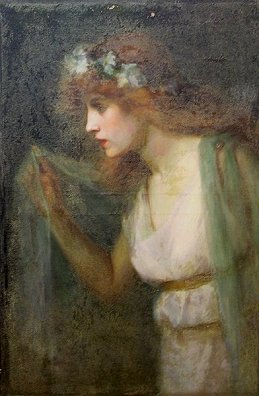
Illustration 17. Sara Page. Whisper of Spring.
Oil on canvas, 1910.©Wolverhampton Art Gallery.
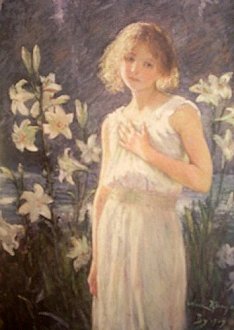
Illustration 18. Anna Klumpke (1856-1942). Among
the Lilies.
Oil on canvas.1909. © San Francisco Fine Art
Museum.
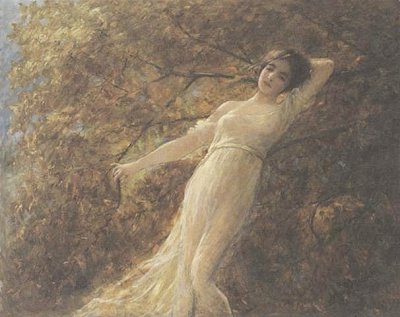
Illustration 19. Anna Klumpke (1856-1942). The
Breeze.
Oil on canvas.1910. © San Francisco Fine Art
Museum.
| Sara Page did not leave any
long-lasting impression or significant artistic legacy.
Today she is practically forgotten. Her works
remained unsold in her studio for years.
The present location of most of them is unknown.
But another reason for this may be her
natural inclination to artistic observation and quiet
study, rather to striving for fame, glory and financial
success:
‘I love the solitude of work and study above all
else. /…/ All mediums seem to me to have their special
use and charm and I work in oils, water colour,
miniature and pastel with delight, as well as ever
interesting black and white. /…/ For a time I exhibited
in the Salon des Beaux Arts, but for some years now at
the Salon des Artistes Francais, besides at times in our
Royal Academy and others, but work and study I love most
of all.’[30]
|
| The author would be very grateful for any additional
information regarding Sara Page’s life, artworks, and
their present location. ©Olga Baird, 2009 |
Sara Page’s addresses and
exhibited works:
|
1892 |
The Poplars, Penn Fields,
Wolverhampton |
Royal
Birmingham Society of artists, 27th
Spring exhibition |
‘A Golden Venetian’ |
|
1892 |
The Poplars,
Penn Fields, Wolverhampton |
Royal Birmingham Society of
artists, 66th Autumn exhibition
|
‘Une Reve’ |
|
1892 |
16, Avenue
Niel, 17eme arrondisement |
Royal Academy |
‘Elsie’ |
|
1893 |
41 Waterloo
Road, Wolverhampton |
Royal
Birmingham Society of artists, 28th
Spring exhibition |
‘Elsie’ |
|
1893 |
16, Avenue Niel, 17eme
arrondisement |
Royal Academy
|
‘Miss Ellen
Wells’ |
|
1893
|
6, rue de Belloy,
16eme arrondissement
|
SAF |
1.‘Portrait
de Mlle E.P.’ oil
2.‘Mada’, pastel
3.‘Une
paysanne bretonne,’ pastel
|
|
1894 |
22
Lichfield Street, Wolverhampton |
Royal
Birmingham Society of artists, 29th
Spring exhibition |
1.‘A Capri Maiden’ (watercolour)
2.‘Study of Fruit’ (oil)
|
|
1894 |
6, rue de Belloy, 16eme
arrondissement
|
Royal
Birmingham Society of artists, 68th
Autumn exhibition |
‘A Breton Peasant’ |
|
1894
|
6, rue de Belloy, 16eme
arrondissement
|
SAF
|
‘Une reponse attendue’ |
|
1894 |
6, rue de Belloy, 16eme
arrondissement
|
Royal Academy
|
‘Elsie Page’ |
|
1895 |
6, rue de Belloy, 16eme
arrondissement |
SAF
|
‘Portrait de Mlle E.P…’ (Elsie
Page?) |
|
1895 |
22
Lichfield Street, Wolverhampton |
Royal
Birmingham Society of artists, 69th
Autumn exhibition |
‘Innocence’ |
|
1896
|
6, rue de Belloy, 16eme
arrondissement |
Royal
Academy
|
‘Harmony in Blue’ |
|
1896 |
6, rue de Belloy, 16eme
arrondissement
|
SAF |
1.‘Portrait de
Mlle K…’ pastel
2.‘Juin’ pastel |
|
1896 |
c/o Mr Percy Young, 137 Gower
Street, London |
Royal
Birmingham Society of artists,70th
Autumn exhibition |
‘Miss Elsie Page’ |
|
1897 |
45, Rue du Marche, Neuilly |
SAF |
1.‘La Marquise’ pastel
2.‘Beatrice’ pastel |
|
1899 |
45, Rue
du Marche, Neuilly |
Royal Birmingham Society of
artists, 34th
Spring exhibition |
‘Beatrice’ |
|
1900 |
83, rue
Perronet,
Neuilly-sur-Seine
|
SAF |
‘Violettes’ |
|
1901
|
83, rue
Perronet,
Neuilly-sur-Seine |
Royal Academy
|
‘The Princess’ |
|
1902
|
83, rue
Perronet,
Neuilly-sur-Seine |
SNBA |
1.‘
Andromeda’
2. Frame containing 2 miniatures |
|
1902 |
83, rue
Perronet,
Neuilly-sur-Seine
|
Royal Academy |
‘La Bella’ (drawing) |
|
1902 |
83, rue
Perronet,
Neuilly-sur-Seine |
Walker Art Gallery, Liverpool |
‘La Bella’ (drawing) |
|
1903
|
83, rue
Perronet, Neuilly-sur-Seine
|
SNBA |
‘Theodora’ |
|
1903 |
c/o Mr
Percy Young |
Royal Birmingham Society of
artists, 77th
Autumn exhibition
|
‘The Lace Maker’ |
|
1906
|
50, rue
Perronet,
Neuilly-sur-Seine |
SNBA |
1.‘Reflection’
2.‘La
Marquise’ (drawing)
|
|
1906 |
50, rue
Perronet,
Neuilly-sur-Seine
|
The Society of Women Artists,
London
|
‘Spring’ |
|
1910
|
50, rue
Perronet,
Neuilly-sur-Seine |
SNBA
|
1.‘Le Rocher qui pleure’ (Weeping
Rock)
2.‘Le marquis’ (drawing)
|
|
1911 |
50, rue
Perronet,
Neuilly-sur-Seine |
SNBA
|
1.‘La
Baugneuse’ (The Bather)
2.‘La
faunesse’ (drawing) |
|
1912
|
50, rue
Perronet,
Neuilly-sur-Seine |
SNBA
|
1.‘La liseuse’ (Reading Woman)
2.'L'écharpe rose’ (The Rose
Scarf, drawing)
3. ‘Jeune fille de France’
(miniature) |
|
1913
|
37, rue
Charles Laffitte, Neuilly-sur-Seine
|
Royal Academy |
‘The Rose Scarf’ |
|
1914 |
37, rue
Charles Laffitte, Neuilly-sur-Seine
|
SNBA |
‘Louise (miniature) |
|
1914
|
37, rue
Charles Laffitte, Neuilly-sur-Seine
|
Royal Academy |
‘Blondina’ |
|
1915
|
37, rue
Charles Laffitte, Neuilly-sur-Seine
|
Royal Academy
|
‘Isobel’ |
|
1916 |
37, rue
Charles Laffitte, Neuilly-sur-Seine
|
Royal Academy
|
‘Isobel’ |
|
1920
|
37, rue
Charles Laffitte, Neuilly-sur-Seine
|
SAF |
‘A la fontaine’ |
|
1925 |
37, rue
Charles Laffitte, Neuilly-sur-Seine
|
SAF |
1.‘La chale
jaune’ miniature
2.‘Solitude’
miniature |
|
1926
|
37, rue
Charles Laffitte, Neuilly-sur-Seine
|
SAF |
‘Le rocher qui pleure’ |
|
1934 |
122,
Argyll Avenue, Luton
|
Royal Birmingham Society of
artists, Spring exhibition |
‘Storm Clouds’ |
|
1935 |
24, Soho
Square, London |
Royal Birmingham Society of
artists, Spring exhibition |
1.‘The Bather’
2.‘Henriette’ |
|
1935 |
78 Penhill Avenue,
Parkstone, Dorset |
61st
Autumn exhibition, Walker Art Gallery, Liverpool |
Miniature: A Russian Princess |
|
1936 |
78 Penhill Avenue,
Parkstone, Dorset |
|
Address given in ‘Year’s Art’, 1936 |
|
|
|
Sold at the Phillips, de Pury and
Co auction (Leeds, 21.06. 1995. Lot 53) |
‘Study of a Woman in Profile
Wearing a Bonnet and Purple Shawl’ |
|
References:
1. Source for the photos of the
Academie Julian:
http://www.dezenovevinte.net/bios/julian.htm
2.Crespon-Halother, Beatrice. Les peintres britanniques
dans les salons parisiens des origins a 1939. 2002.
[1]
A catalogue of Birmingham and West Midlands Painters of
the Nineteenth Century.
[2]
History of WAG, scrap book. WAG.
[3]
http://www.localhistory.scit.wlv.ac.uk/articles/streets/namesp.htm
[4]
Wolverhampton Local Studies. DX-831/4/1.
[5]
Letter from Sara Page to A Cooper, the Keeper of WAG. 13
February 1926. WAG, artist’s file.
[6]
Ibid.
[7]
Ibid.
[8]
The history of the Academy Julian attracted recently an
attention of art historians, particularly the Americans.
The exhibition ‘Overcoming All Obstacles: The Women
of the Academie Juluan’ organised by the Dahesh
Museum, NY in 2000 and a number of related publications
revealed many important and interesting facts. See:
Fehrer Catherine. The Julian Academie. Paris 1868-1939.
Shepherd Gallery, NY. 1989; Farmer, J.David (Director of
Dahesh Museum, NY). Overcoming All Obstacles: The Women
of the Académie Julian. An Exhibition Organized by the
Dahesh Museum.
http://www.californiaartclub.org/newsletter/articles/article_julian2.shtml;
Weisberg, Gabriel P. and Becker, Jane Becker [Ed.]
Overcoming All Obstacles: The Women of the Académie
Julian. New York, Dahesh Museum of Art, 1999; Weisberg,
Gabriel P. Against the Modern: Dagnan-Bouveret and the
Transformation of the Academic Tradition. New York,
Dahesh Museum of Art. 2002;
[9]
Elizabeth Otis Williams. Sojourning, Shopping and
Studying in Paris. A Handbook Particularly for Women.
With Map. Chicago. 1907.
[10]AS 63. Archives of the Académie Julian. National
Archives of France; Academie Julian Journal. 1901-1914.
National Library of France.
[11]
Fehrer Catherine. The Julian Académie.
Paris 1868-1939.
Shepherd
Gallery, NY. 1989.
[12]
Palais des Champs Elysees. Explication des ouvrages de
peinture, sculpture, architecture, graveure and
lithographue des artistes vivants. Paris, 1893. P.123.
[13]
Ibid.
[14]
Alfred Nettlement. William Bouguereau. L’Acaédemie
Julian, Jan.1906, p.3 (in French). Quoted in: J Peck. In
the studios of Paris: William Bouguereau and his
American students. 2006. P.52.
[15]
Letter from Sara Page to A Cooper, the Keeper of WAG. 13
February 1926
[16]
Ibid.
[17]
Catalogue of a Loan Exhibition of the Works by
Dagnan-Bouveret. Chicago, 1901.
[18]
Elizabeth Otis Williams. Sojourning, Shopping and
Studying in Paris. 1907.
[19]
Letter from Sara Page to A Cooper, the Keeper of WAG. 13
February 1926
[20]
http://www.npg.org.uk/live/artistsupp_y.asp
[21]The
Society of Women Artists Exhibitors. 1855-1996. Vol.3.
Hilmarton Manor Press, 1996, p.218.
[22]
Royal Academy Exhibitors. 1905-1970. Vol.5, 1981.
[23]
http://www.findagrave.com/cgi-bin/fg.cgi?page=gr&GSln=page
[24]
http://www.wolverhamptonwarmemorials.org.uk/memorial_pages/Church/st_bartholomews_penn.htm
[25]
Ibid.
[26]
CMB/Wol/G/AGPL/2. Sara Page’s letter from 30.01.1926.
Wolverhampton Local Studies. Art Gallery and Public
Library Minute Book 3. P.78.
[27]
C. W. T. Page: ‘Design for Living’, ‘Mountains near
Coniston’, ‘The Quarry’, ‘Langdale Pikes from Hoathwaite’,
‘March Landscape’, ‘An Upland Farm’, ‘The Mawddach from
Arthog’.
[28]
CMB/Wol/G/AGPL/5. Elizabeth Page’s letter from
3.05.1943. Wolverhampton Local Studies. Art Gallery and
Public Library Minute Book 6. P.1. Royal Academy
Exhibitors. 1905-1970. Vol.5, 1981; Wolverhampton Local
History Archives, Art Gallery and Public Library
minutes, book 7, 19.04.1943: ‘Ms Page, the surviving
sister of the late Ms Sara Page has presented to the
Gallery a miniature by the latter entitled ‘The
Princess’. CMB/WOL/AGPL/6.
[29]
See: Peck, James F. In the studios of Paris: William
Bouguereau and his American Students. 2006. P.166.
[30]
Ibid.
 |
Return to
the
previous page |
|
